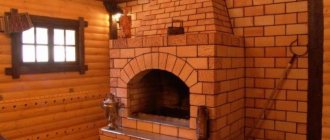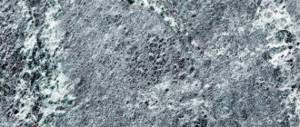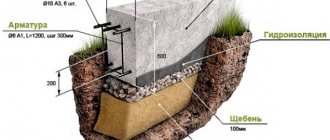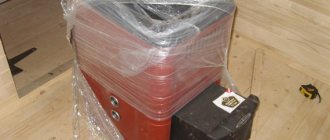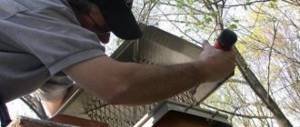Why plaster the stove?
The answer to the question of when and why it is necessary to plaster a stove is very important. Having understood it, you can accurately decide whether this process is really necessary or whether decorative finishing from ceramic or fireclay tiles is sufficient.
There are several reasons that necessarily require plastering of surfaces:
- The stove was built a long time ago, and the old plaster was partially cracked and began to peel off. As a result, bare areas look unattractive.
- There is a risk of carbon monoxide leaking into the cracking masonry joints of an old stove.
- During the renovation process, it is necessary to change the style of the overall interior, as a result of which the stove needs to be given a more neat appearance or completely transformed.
- There was a need to treat the seams between the rows of bricks, in which settlements of various insects were found. This happens when solutions based on natural materials are used for laying the stove. Plastering the stove prevents the appearance and reproduction of insects.
- The masonry of the stove is not done carefully, which spoils the appearance of both the structure and the entire room. With the help of plaster you can completely solve a problem of this kind.
If we compare plaster with other types of finishing materials, we can note several advantageous points:
- Plastering is the simplest and most affordable way to put the stove in order.
- The mixture for plastering the surface is much cheaper compared to ceramic tiles or stove tiles. This allows you to significantly save material resources.
- The plaster mixture can be used to finish a newly built stove or to reconstruct an old building element.
- The applied layer of plaster makes the walls of the furnace thicker, therefore, the heat capacity coefficient of the structure increases. As a result, the furnace takes longer to cool down, resulting in reduced fuel costs.
- A plastered stove becomes less fire hazardous, and the risk of carbon monoxide entering the room is also reduced.
- After the plaster mixture has dried, you can use various materials to finish the oven. This can be water-based paint, lime mortar or decorative plaster.
To avoid problems...
- If the plaster is applied to dry brick, you will not be able to avoid peeling. And too intense moisturizing will lead to scratches and the need to redo the work after the masonry has dried.
- If you use poorly slaked lime, miniature bumps may appear.
- The main cause of cracks is improperly mixed mortar. Moreover, most often the “to blame” for this is too oily clay, diluted with a small amount of sand.
- Cracks can also appear if the applied layers of plaster are too thick or as a result of the previous layer not setting sufficiently.
As you can see, you don’t need to be a seasoned stove maker to plaster a brick stove yourself. And if you still have doubts about whether you can do everything without additional help, watch a video on this topic
Tools - how to plaster a stove in the house
The service life of a plastered surface largely depends on the adhesion of materials, and for this it is necessary to correctly apply the plaster and distribute it evenly on the surface of the stove.
You can solve the question of how to plaster a stove without cracking using special tools, which include the following:
- Putty knife. Several types of spatulas are used; with the help of some tools the solution is collected from a container, while with others it is applied to the surface.
- Plastering hammer. This tool is used to drive plaster nails.
- Trowel. Using this tool, the solution is evenly distributed on the stove wall.
- A hammer-cam is necessary for working with a chisel or a trojan.
- Scissors are ordinary and for cutting metal. If you use fiberglass mesh in the process, you will need ordinary scissors; you need to cut the chain-link mesh with metal scissors.
- A grater is necessary for leveling and smoothing a plastered stove wall.
- Using a smoother, the surface is brought to perfect smoothness.
- A chisel is used to make notches on the surface of the stove, this promotes better adhesion of the plaster and the working surface.
- Brushes. It is necessary to purchase several types of this tool, since some are used to apply primer, while others can be used to apply textured plaster.
- Using a building level, check the vertical and horizontal level of the working surface.
- Using a plumb line, the evenness of the walls and the applied plaster solution is controlled.
- As a rule, the mixture is distributed between beacons, which are installed on the walls for even plastering of the surface.
Types of mortar for plastering stove walls
The stove is one of the building elements that regularly heats up and cools down, so the chosen plaster composition must be resistant to this phenomenon.
Mixtures for preparing plaster mortar are divided into two types:
- Simple compositions that include only two components, sand and clay.
- Complex formulations contain more than two ingredients.
Plastering a stove with clay and sand requires preliminary preparation and cleaning of the materials from various impurities. In particular, sand must be sifted through a fine sieve, clay should be rubbed through a fine mesh to remove roots and small stones.
It is recommended to make the plaster mixture using fatty types of clay, this promotes better adhesion of the solution to the surface. If the clay is too oily, the amount of sand used can be increased.
You need to know how to dilute clay for plastering a stove. To begin with, it should be soaked in a small amount of water and left for several hours, adding liquid in small portions if necessary. The process is repeated until a 10-15 cm layer of water remains above the clay. After mixing the finished clay mixture, the consistency of thick sour cream should be obtained.
In some cases, asbestos, finely chopped straw or fiberglass are added to the mixture for plastering the stove. These reinforcing components make it possible to obtain more durable materials.
When preparing plaster mixtures, special attention must be paid to the environmental side. During the heating process, the materials used should not emit substances that pose a danger to human health and life.
Separately, it should be said about salt; it is also sometimes added to the solution for plastering the stove. It should be noted that the opinion that salt makes it stronger can be considered erroneous. In fact, salt increases the hygroscopicity of clay, making it more flexible and resistant to cracking. Also, a plastering solution, to which a certain amount of salt is added, prevents the proliferation of various insects in masonry joints. For owners of private houses, this fact is of great importance.
Another component that can be added to the plaster mixture is gypsum powder. This material is used as a fixative. However, plaster must be used very carefully, as it hardens very quickly. The initial setting of the solution with the addition of gypsum powder occurs immediately after application, and after 10-15 minutes the surface hardens completely.
Adding lime along with gypsum makes the solution more durable and able to dry in a short time. But when choosing such mixtures, you should remember the properties of gypsum, so it is better to prepare a small portion immediately before plastering the stove. It is very important to understand that it is impossible to dilute the gypsum mixture with water.
How to plaster a brick oven
It is necessary to choose the mixture for plastering the stove wisely. Finishing the stove with a standard building mixture is impractical. Due to temperature fluctuations and their high values, heat-resistant plaster is needed. Plasticity indicators are also important to prevent cracking and even shedding of the coating during the firing of the furnace.
Ready mix
You can always find special plaster mixtures for stoves on sale. A solution prepared according to instructions in most cases guarantees ease of application. Heat resistance is ensured by the presence of additives, and the components are selected in the required proportions. The disadvantage of special plaster is the cost.
How to make the solution yourself
The main components present in the mixture give the solution its name.
From clay
Preparation begins by soaking the clay in warm water until it swells. There is no need to stir the mixture; just strain it before adding sand. An experienced master knows how much is required for mixing, depending on the consistency of the starting material. Usually 1 measure of clay to 2–2.5 parts of sand; an indicator of the readiness of the solution is the appearance of clots sticking to the stick or nozzle. To increase the binding properties and reinforce the coating, at least 10% asbestos or fiberglass is added.
The option of coating the stove with a clay composition is quite common. Besides the price, the advantages are:
- ease of application;
- greater plasticity;
- high drying strength.
It is not a fact that the first time you will be able to maintain the proportions and get a working composition. But with the low cost of ingredients, you can experiment to get a solution of optimal consistency.
Fireclay clay
Not the most suitable material for a beginner is fireclay clay, also called kaolin. The plaster can crack, because when exposed to high temperatures, fireclay loses its plasticity. The defect is eliminated by adding quartz sand, a special adhesive composition, and fiberglass particles for reinforcement to the solution.
Why choose such a composition? It’s simple: by coating the furnace with fireclay clay, you’ll get better fire resistance as a result. Plus, natural ingredients and beautiful textured fabric.
Fireclay clay does not tolerate high humidity. Before purchasing or using, you should make sure that the storage rules have not been violated, the mixture has not been exposed to water and has not hardened in pieces. You should not work with damaged material.
With the addition of cement
Based on clay mortar, you can make cement plaster for a brick kiln. In addition to the good thermal conductivity of the composition, the increased strength of the coating is added.
Clay, sand and cement are taken in approximate proportions of 1:2:1. The total amount of solution is mixed in small quantities, which is determined by the drying rate of the plastic mass. After an hour, such plaster will harden and become unusable. You should not skimp on strength; cement grades of 400 and higher are selected to add to the base.
What is better to plaster?
The answer is different for everyone. Depends on the level of skill and budget. By and large, you can choose any of the given compositions for plaster, and with the right recipe and some experience, the plaster will hold up well and not crack.
Inexpensive options with mixing ingredients yourself are suitable for professionals. But a beginner should not be afraid to experiment if they have a limited budget or lack of a good hardware store nearby; the main thing is to approach it responsibly.
Choosing a ready-made packaged plaster mixture significantly reduces the preparatory period. Allows you to avoid mistakes in cooking. If opportunities allow such a purchase, all that remains is to study the assortment.
Whatever the coating, before starting work on a new stove, you need to make sure that the masonry is dry and stable. Rushing will only harm the process, and the finished coating will have to pay for it. At a minimum - shrinkage cracks.
How to plaster a brick stove with your own hands
You can finish the stove using plaster mortar yourself; you need to know how to properly plaster the stove and follow the sequence of actions.
Preparatory stage
The quality of plastering in most cases depends on how correctly the preparatory work on the surface is done. Good preparation of the stove walls is the key to better adhesion of the plaster mortar to the surface.
The preparation process involves performing the following actions:
- To reconstruct a stove or fireplace, it is necessary to remove old plaster from the surface using a chisel and hammer. Then the wall is cleaned of dust using a regular or iron brush.
- The newly built stove is cleaned of any remaining masonry mortar. Neglecting this step may cause poor adhesion of the plaster to the working surface. As a result, after some time the plaster will begin to lag behind the walls of the oven.
- After cleaning the surface, it is necessary to deepen the masonry joints. Moreover, this step is necessary both for the structure being restored and for a new stove. It is also recommended to remove dust from the seams.
- The next step is to apply a primer to the stove walls. It is best to work with a thin brush so that the buried seams are not left untreated.
- The process of plastering uneven walls should always be accompanied by surface reinforcement. To strengthen the furnace walls, a metal or fiberglass mesh with cells of 1.5 * 1.5 or 2 * 2 mm is used. Reinforcement helps strengthen the plaster on the surface, making it more resistant to temperature changes. The use of reinforcing materials makes it possible to apply a thick layer of plaster, thereby increasing the heat capacity of the furnace. To fix the metal mesh, use nails with a wide head. When using fiberglass mesh, you need to apply a thin layer of plaster to the wall, embed the mesh in it, apply additional mortar and level it. It is recommended to use fiberglass on walls with slight unevenness.
- To preserve or restore corners, it is recommended to use steel or perforated aluminum corners, which are attached to an adhesive solution.
- For large differences, surface evenness is achieved by installing beacons. They are fixed to a gypsum mortar, which allows you to carry out work almost without stopping. If you have enough free time, you can attach the beacons to the clay solution, but it is better to do this with the reinforcing mesh in close contact with the wall.
- The preparatory layer of plaster can be perfectly smooth or rough. The first option is used for whitewashing or painting, the second – for decorative relief plaster. It should be remembered that ceramic tiles and decorative plaster do not require a very thick preparatory layer.
Applying plaster to the walls of the oven to prevent cracking
Before plastering the stove in the house, you need to familiarize yourself with the methods used.
Method No. 1 is most often used to level walls that have large distortions. In other words, when a layer thickness of 5-8 cm is required, the process proceeds as follows:
- They set up beacons that allow you to maximally level the surface with large differences. During the installation process, a building level is used, with its help you can achieve perfect evenness.
- Next, the stove is heated so that its walls are warm.
- Using a roller or wide brush, moisten the furnace wall with water to hammer fine dust and dry mortar into the masonry joints.
- The entire surface is covered with a primer and left until completely dry. Priming promotes good adhesion of the working solution to the surface.
- The first layer of plaster is applied using the sketch method; its thickness should not exceed 4-5 mm. In this case, the solution should not be very thick. Throwing the mortar must be accentuated in order to ensure that it gets into the seam between the bricks. After sketching the entire surface, leave the solution for plastering the stove until it dries.
- After this, they begin to apply the next layer; it should protrude 1 cm above the beacons. Work begins in the lower part of the oven, throwing the solution between the beacons to a height of 40-50 cm. By pressing the rule against the beacons, the applied mixture is leveled. After this, move on to the next section and repeat the entire process. Without waiting for the plaster to dry completely, grind the work surface using grout.
To prevent cracks from forming on the surface of the plaster layer during the drying process, stove makers with many years of experience advise covering the stove walls with damp burlap after applying the mixture for plastering the stove. If the fabric dries quickly, you can moisten it.
The burlap is removed from the dried surface, and the surface is rubbed and smoothed using a trowel with a rubber surface.
- For the third layer, it is necessary to prepare a more liquid solution for plastering the stove; its thickness should be 1.5-2 mm, since it is used to smooth the plastered surface. The third layer is applied only before painting or whitewashing.
- Making corners, even those reinforced with a metal corner, is considered a rather complicated process even for experienced craftsmen. To simplify the work, use an angled spatula. With this tool, the solution is easily applied and leveled well. If it is impossible to purchase such a spatula, use a wooden strip. It is fixed on one side of the corner and the solution is applied. After drying, the lath is removed and moved to the other side, and the solution is applied to the other side of the stove corner.
- In some cases, the edge of the corner is rounded. This makes it safer for small children and avoids chipping.
Method No. 2 of solving the question of how to plaster a stove with your own hands involves putting it in order using a metal mesh netting. This material is intended to reinforce the surface and give the required thickness to the plaster layer.
The surface is leveled as follows: pieces of wire no more than 25 mm thick are placed under the fixed metal mesh in the right places, hooking it onto the mesh or pre-installed metal slats.
The plaster is applied in several layers, similar to the first method, but the mesh must be completely covered with a plaster layer.
When applying the first layer, you should make sure that the solution passes through the oven plaster mesh and adheres to the wall. After spraying, the surface is left to dry. When the plaster dries, the mesh becomes motionless, so subsequent leveling layers are applied more easily and easily.
The last layer is leveled, allowed to dry, and the cracks that appear on the surface are covered and rubbed (read also: “How to cover up cracks on a stove - options for solving the problem”).
Finally, the decorative coating is installed.
Plastering stove walls in this way allows you to obtain a durable finish that is securely attached to the surface.
Method No. 3 is used for smooth stove walls that require minor cosmetic repairs, so the solution is applied once or twice, maintaining a total thickness of no more than 5-6 mm.
Surface preparation is carried out by analogy with the first methods, always applying a layer of primer for a brick oven.
It is allowed to use metal slats-beacons, which allow you to control the thickness of the plaster layer. However, when plastering smooth walls, guides do not need to be used.
The plaster mixture for cosmetic repairs of the furnace must contain fireclay clay and crushed asbestos. In this case, you can get a more durable solution and, accordingly, a high-quality finish.
It is best to apply the mixture for plastering stoves from the bottom up, using a wide spatula. It is best to level the plaster using a rule, pressing it against the metal slats. If they are absent, the solution is evenly distributed over the surface, checking the evenness using a building level.
It is also recommended to use a corner spatula to remove corners.
After applying the plaster mortar to the entire surface of the stove wall, carefully level it with grout.
This finish can serve as the basis for ceramic or fireclay tiles, as well as decorative relief plaster.
Photo report on plastering the stove
In this case, the master used a reinforcing mesh: the brick had many cracks, and the small cell simultaneously reinforces the masonry. First, the old finish is cleaned off, everything is removed, down to the bare brick. The seams deepen approximately 1 cm.
The entire finish of the stove is knocked down, right down to the brick.
The seams are deepened, the surface is cleaned
The surface is cleaned of dust - first with a broom, then with a thick brush. Then the mesh is fixed.
The mesh on the stove will prevent the plaster from falling
The mesh is attached at intervals to nails driven into the seams. Use soft burnt wire
To ensure that the surface of the oven is level, beacons are placed. Standard galvanized or stainless steel construction beacons are used. Plastering on them is carried out as usual. Only first the composition is applied and leveled around the casting, and then the entire surface is tightened.
First they plaster around the casting
The stoves are plastered over the beacons, as usual
The composition for plaster is as follows: 1 part cement, 2 parts mountain sand, 2 parts river sand, 200 grams of salt. Clay is not added at all, because it dries out too much, causing cracks to appear.
Before starting work, the oven is well wetted so that it is moist during operation. The kiln is not heated until the cement has fully gained strength (28 days).
After the plaster has dried, you can glue the tiles (using heat-resistant tile adhesive), paint, whitewash, do whatever you like.
Finishing the stove with tiles can be bright
Decorative finishing
The decorative design of the stove walls is carried out in accordance with the taste preferences of the owner. An evenly plastered surface can simply be whitewashed; by the way, whitewashing is a traditional finishing method that has been used since ancient times. The whitewashed surface was often painted with imported paints, giving the room originality and emphasizing national traditions. In most cases, the ornament was selected according to local traditions.
Modern technologies and materials make it possible to create an imitation of natural stone or a uniform relief structure on the surface of the stove wall.
Quite often, craftsmen with a wide imagination decorate stoves with elements of three-dimensional designs, using various available means for this purpose. In particular, we are talking about plastic film, brushes, brushes and other materials and objects.
Creative people create relief compositions from decorative plaster, allowing them to protrude slightly beyond the stove walls. Subsequently, all this is covered with paints. Moreover, applying the coloring composition to wet decorative plaster promotes deeper penetration and increases the service life of the decorative finish.
In some cases, the dried surface is additionally painted, which allows for a brighter design.
Terracotta or ceramic tiles can be used as decorative finishing for stove walls. The additional purchase of corner finishing elements makes the installation of tiles and decoration simpler and more convenient, allowing you to obtain neat and aesthetic corners. The tiles are installed using a special cement-based adhesive composition, which is resistant to temperature changes.
Some subtleties of plastering a stove with a mixture of sand and clay
When plastering stoves with your own hands, it is important to take into account several main points, on which the quality of the work largely depends:
- It is not recommended to plaster a newly erected stove. The structure must go through the drying and shrinking stage. For this purpose, the stove must be heated regularly for 2-3 months, after which finishing work can begin.
- It is best to paint plastered stove walls with water-based paints. The use of other formulations may cause the release of harmful substances and unpleasant odors.
- All materials used to decorate stove walls must have a natural base so as not to pose a danger to human health.
All the methods described for plastering a stove cannot be called simple for independent use. Therefore, in the absence of initial knowledge and experience, it is better to entrust the plastering of a brick stove to professional craftsmen. In this case, you can get a high-quality result and avoid unnecessary consumption of materials.
Basic concepts and goals
It doesn’t matter whether it’s a new or old heating structure, you will still have to apply a new layer of plaster to a clean brick surface. Therefore, before plastering the stove with your own hands, you need to thoroughly clean all surfaces on which the solution will be applied.
The requirements for a new coating in conditions of constant heating of the base to high temperatures are quite high, therefore both the base itself and the mixture must be correctly selected.
Plastering stoves is a responsible task that must also be approached from an environmental point of view. Indeed, with constant heating and cooling, all substances that are destroyed by increasing the temperature of organic and inorganic inclusions will inevitably be released from the mixture.
Therefore, the base must not only be environmentally friendly in itself, but also be as free from impurities as possible. Also, the material used must meet certain technical requirements, in particular, have a high degree of elasticity so that the plaster does not crack, and also have high thermal conductivity.
Do I need to prepare the base?
For what? This may not be the main question, but still.
After plastering, the stove will look neater and, if not decorated, will be in harmony with the interior. It will be possible to paint the surface later, just choose special paints and varnishes. This is the first.
Second: the masonry will not only be stronger, but also more airtight. As a result, heat loss is eliminated, and smoke from the firebox will not penetrate into the room. Your room will not be smoky, you will need to clean less often, the furniture and curtains will not turn black, and most importantly, your health will not deteriorate. Respiratory tract diseases due to a malfunctioning stove are a common phenomenon.


